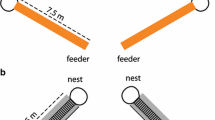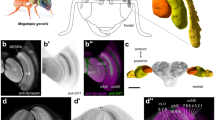Summary
The spectral cues used in the bee's celestial compass are investigated by presenting bees dancing on a horizontal comb with unpolarized (or polarized) spectral stimuli. Where appropriate, the use of e-vector information is prevented by painting out the specialized dorsal margin of the bee's eye (POL area, Fig. 1). This area has been shown to mediate e-vector information (Fig. 3; Wehner 1982), whereas the remainder of the dorsal retina is sufficient for mediating spectral information (Fig. 4).
Spectral cues are used by the bees to discriminate between sun and sky (Fig. 4). According to physical reality (Fig. 2), a long-wavelength stimulus is taken as the sun, whereas a short-wavelength stimulus is expected by the bee to lie anywhere within the antisolar half of the sky (Figs. 5 and 6). This is in accord with the bee's e-vector compass in which e-vectors are confined to the antisolar half of the sky (Fig. 9).
In general, spectral cues do not provide precise compass information except when a full celestial colour gradient is available including the solar and the antisolar meridian (Figs. 7 and 8).
Similar content being viewed by others
References
Batschelet E (1965) Statistical methods for the analysis of problems in animal orientation and certain biological rhythms. Am Inst Biol Sci, Washington
Brines ML, Gould JL (1979) Bees have rules. Science 206:571–573
Edrich W (1977) Die Rolle einzelner Farbrezeptoren bei den verschiedenen Lichtreaktionen der Biene. Verh Dtsch Zool Ges 1977:236
Edrich W, Neumeyer C, Heiversen O von (1979) ‘Anti-sun orientation’ of bees with regard to a field of ultraviolet light. J Comp Physiol 134:151–157
Frisch K von (1949) Die Polarisation des Himmelslichtes als orientierender Faktor bei den Tänzen der Bienen. Experientia 5:142–148
Glas H van der (1975) Polarization induced colour patterns: a model of the perception of the polarized skylight by insects. I. Tests in choice experiments with running honey bees,Apis mellifera. Neth J Zool 25:476–505
Glas H van der (1976) Polarization induced colour patterns: a model of the perception of the polarized skylight by insects. II. Experiments with direction trained dancing bees,Apis mellifera. Neth J Zool 26:383–413
Glas H van der (1980) Orientation of bees,Apis mellifera, to unpolarized colour patterns, simulating the polarized zenith skylight pattern. J Comp Physiol 139:225–241
Helversen O von, Edrich W (1974) Der Polarisationsempfänger im Bienenauge: ein Ultraviolettreceptor. J Comp Physiol 94:33–47
Meyer EP, Labhart T (1981) Pore canals in the cornea of a functionally specialized area of the honey bee's compound eye. Cell Tissue Res 216:491–501
Nagel MR, Quenzel H, Kweta W, Wendling R (1978) Daylight illumination — Color — Contrast tables for full-form objects. Academic Press, New York San Francisco London
Rossel S, Wehner R, Lindauer M (1978) E-vector orientation in bees. J. Comp Physiol 125:1–12
Rossel S, Wehner R (1982) The bee's map of the e-vector pattern in the sky. Proc Natl Acad Sci USA 79:4451–4455
Rossel S, Wehner R (1984) How bees analyse the polarization patterns in the sky. Experiments and model. J Comp Physiol A 154:607–615
Sommer EW (1979) Untersuchungen zur topographischen Anatomie der Retina und zur Sehfeldtopologie im Auge der Honigbiene,Apis mellifera (Hymenoptera). PhD thesis, University of Zürich
Waterman TH (1981) Polarization sensitivity. In: Autrum H (ed) Vision in invertebrates (Handbook of sensory physiology, vol VII/6B) Springer, Berlin Heidelberg New York, pp 281–469
Wehner R (1982) Himmelsnavigation bei Insekten. Neurophysiologie und Verhalten. Neujahrsbl Naturforsch Ges Zürich 184:1–132
Wehner R, Rossel S (in press) The bee's celestial compass — A case study in behavioural neurobiology. In: Lindauer M, Hölldobler B (eds) Experimental behavioural ecology and sociobiology. In memoriam Karl von Frisch. Fischer, Stuttgart
Author information
Authors and Affiliations
Rights and permissions
About this article
Cite this article
Rossel, S., Wehner, R. Celestial orientation in bees: the use of spectral cues. J. Comp. Physiol. 155, 605–613 (1984). https://doi.org/10.1007/BF00610846
Accepted:
Issue Date:
DOI: https://doi.org/10.1007/BF00610846




